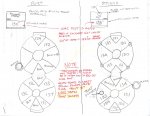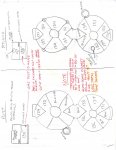
1990 Johnson 115 V4 Crossflow Bubbleback
I dismantled and cleaned both cylinder heads and caps, and cleaned thermostat housing and changed all the parts and the rubber hoses. I took the boat out on three trips and it ran perfect.
Today, out of curiosity, I put the flusher on and ran the engine at home till it got as hot as it gets in the flusher, in the 130's, and used a temperature gun on different parts of the cylinder head cover. I wanted to compare them to the temperature where OMC instructs to test the temperature, at the top of the cylinder heads. The attached drawing shows the temperatures at the different points of the cylinder head cover plate. It also shows the temperature at the top of the heads (the small drawing at the top left of each drawing port and starboard. The points that say blocked, are points where other parts obstruct my being able to get a reading. I hope everyone understands my handwriting.
I previously had located my new Teleflex temperature gauge sender on the Port cylinder at the 8 o'clock point marked in the drawing, because it showed as the hottest point on the Port side. Subsequently, it occurred to me that the temperature of the cylinder head might be a hotter point, therefore, I undertook this test. Bottom line: the worst cylinder head temperature is the Port side, likely because it has the power pack there, and it is 5% cooler (130 degrees), than the point where temperature gauge is located which has a reading of 135 degrees.
I can't put a temperature gauge at every point on the engine, therefore, at least it looks like the place I located it, is the hottest point. OMC says to check engine if the temperature exceeds 160 degrees at the head. This means that the temperature gauge should not exceed 165. I also have a water pressure gauge installed on the engine, as well as the two high temperature alarm senders and alarms that came with the engine.
Attachments
Last edited:




















